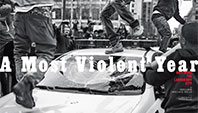 |
1. “Just as all of Baltimore pondered the mystery of how a progressive city could produce such despotic police orcs,” wrote Benjamin Wallace-Wells in his in-depth story of how Baltimore descended into violence following the death of Freddie Gray, a 24-year-old Baltimore resident who died in police custody last spring, “a second mystery had presented itself: If everyone was organized to prevent violence, why did it continue to happen?” (“A Most Violent Year,” November 30–December 13). “So many conversations in Baltimore this fall gnaw at these two questions,” tweeted Daschloz. “Very thorough article,” wrote commenter william.washington. “As a third generation Baltimorean, I and my family have watched as areas which were middle class fell into decay. The problem with Baltimore is that it is run like a mining operation. Money only goes into capital which will extract revenue for refining elsewhere. There are few who do well (the median income earned in the city is [substantially] below the national median income) but most eke out whatever existence they can.” Some were just thankful that the story took on such a weighty subject. “There’s been a great piece crying out to be done about post-riot Baltimore,” tweeted ProPublica’s Alec MacGillis. “Ben Wallace-Wells rose to the challenge.” He later elaborated: “Telling scene: drug dealer pleading w/ cops to start policing again.” Many were simply impressed with the artful storytelling. “Restrained, beautiful, gripping …” tweeted the New York Times’ Alan Feuer.
 |
2. Last issue’s story on the lives of former internet sensations “long after the clicks have subsided” provided readers with a glimpse of just how disorienting, even traumatic, viral fame can be (“I Was Internet Famous,” November 30–December 13). “It’s only been in the past ten years or so that an ordinary person can wake up and find himself globally famous due to a viral video,” wrote a commenter at Neatorama. “That experience can be pretty shocking. For some, it’s led to greater things while others are still dealing with the scars of notoriety.” Reality Steve thought the interviews were “depressing. We found out that Caitlin Upton basically went into depression and almost tried to kill herself for two years” after her Miss Teen USA video went viral. “Does that mean we should all feel guilty now for laughing at [the video]?” “The internet loves wacky characters who get caught doing embarrassing, funny, and unexpected things,” wrote a commenter at Someecards. “But behind the joke there’s always a real person who has to deal with the fallout of being the most famous person on YouTube that week. [These] are some of the darker excerpts of their experience that will make you reconsider whether you want to repost the next viral video you see.” Teen Vogue’s Emma Sarran Webster felt there was a larger life lesson from their stories: “Regardless of the mistakes someone’s made,” she wrote, “it’s important to remember that behind every meme, there’s a real person who deserves to be treated with the decency we’d want for ourselves.” One of the more positive post-fame experiences was that of Tay Zonday, of “Chocolate Rain” fame, who managed to turn his moment in the spotlight into a career. “I’d love to read a column by him on digital culture,” wrote commenter Niandra. Other readers were quick to point out one unintentional omission: “Is no one going to call out Chris Crocker and the author of this article for completely leaving out his extensive career in gay porn?” asked commenter readymade. And of course readers had their own favorite viral stars they wanted to hear from. “If only they could find Scumbag Steve,” wrote a commenter at the Interrobang. Commenter LvV was impressed with the whole bunch: “These are smart and charismatic young people and they became meme-worthy for a reason, because they are awesome.”
3. Genevieve Smith’s account of one man’s experience with Vivitrol, a drug meant to prevent heroin addicts from getting high, prompted readers to share their stories of addiction (“What Comes After Addiction,” November 30–December 13). “My daughter is kicking heroin and for now ‘real life’ just looks like a boring, joyless wasteland to her,” wrote commenter Trilby16. “I was very interested to read an explanation of this ‘excessive anhedonia’ ” — a medical term for the inability to experience pleasure, which is often a lingering effect of drug addiction. “Never heard of that before. It might help her to know that it will end someday.” Another commenter, Bazouges, shared his own story to show how difficult it can be to kick a habit without help: “Twenty years ago, my girlfriend and I had a serious heroin/cocaine addiction. It was full blown for about 2 years and we only stopped because our funds ran out. Even though I thought I could quit on my own, I couldn’t: I had to go to rehab for two weeks then live in shared housing with other addicts for 5 months. I can’t stress enough that no matter HOW strong you feel after being clean, for a month, a year, two years — you’ll be HIGHLY prone to relapsing. The good news is, it is possible to get off the Hell Train. And life is wonderful once you do.”